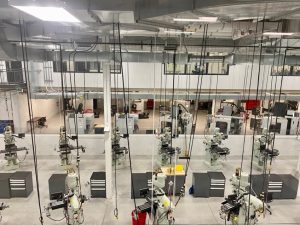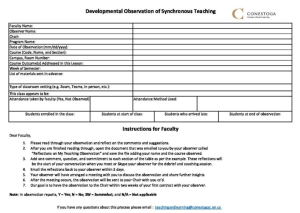3.4 Getting Feedback on Your Teaching
Learning Outcomes
Describe faculty feedback opportunities, including
- Early Course Check-in
- Student Appraisal of Teaching (SAT)
- the Developmental Observation of Teaching process
- other ways to get teacher feedback
The Lyons Model of Teacher Efficacy and Competence

Continuous improvement is a core attitude and practice for growing teachers. Conestoga encourages and provides tools for teaching feedback.
The Lyons Model of Teacher Development describes 5 stages of teacher efficacy. Teachers normally progress through these levels with increased experience over time. However, some teachers never achieve the highest level, even after years of teaching.
- Novice
- Advanced Beginner
- Competent
- Proficient
- Expert
How can a teacher develop to move through the stages? According to Lyons (2014), the most useful practice for moving up these phases is reflection. Reflection-in-action is done while engaging in an activity and reflection-about-action afterwards. As their skills progress, teachers become increasingly aware of outcomes and their importance in the learning process.
There are several ways that Conestoga provides faculty with opportunities to reflect-about-action through feedback on their teaching.
The Student Appraisal of Teaching (SAT) and Early Check-in

Conestoga provides course feedback resources for selected faculty. Below are some items that students are asked to describe in terms of their learning experience in your course.
- Treats me with respect
- Use of eConestoga
- Opportunities to ask questions
- Relevant, useful resources
- Clear instructions
- Helpful feedback
- Variety of activities
SAT
The Student Appraisal of Teaching (SAT) is a college-administered survey completed by students in the second half of the semester. The survey has approximately 40 questions or items.
Did you know? Respect (#20 in the Rapport section of the SAT) correlates with positives on other items. If your score for respect is high, you will likely be high on other items.
The Student Appraisal of Teaching aims to provide faculty with feedback from students’ experiences. The report also provides faculty with comparisons and historical trends. These documents are not shared publicly.
Chairs/Chair Designates decide who gets SATs; not all faculty receive SAT course evaluations each term. Full-time faculty will get a SAT every two years. SAT responses are available after the course.
It can be useful to reflect on SAT items after your course is completed to set development goals and work towards improving your teaching practice in the future.
ECC
The Early Course Check-In (ECC) is a college-administered survey completed by students in the first half of the course. The survey has 5 to 6 questions or items.
The purpose of the ECC is to provide faculty with early feedback so they may adjust aspects of their teaching. This gives faculty feedback partway through the course so they may adjust their teaching practices where necessary.
On several occasions, students will be advised about the ECC survey by email and eConestoga. Faculty who receive an ECC will also typically receive a SAT.
5-Minute Reflection Activity
After you have viewed the SAT and Early Course Check-In, reflect on these questions:
- What is one item that reflects a strategy you already apply in your teaching?
- What is one item that you would like to develop further in your teaching?
- What sources would you seek for ideas to improve as a professional educator?
Developmental Observation of Teaching
Review this short introduction video to the Developmental Observation of Teaching Process.
Teaching & Learning. (2022). Observation of teaching process. [Online video]. Youtube.
The Developmental Observation of Teaching (observation) is a Teaching & Learning-administered process completed collaboratively by a skilled teacher and a faculty member in the first half of the course.

The purpose of the observation is to provide faculty with input on effective teaching using a standardized report form. The observation process enables faculty to move through a guided self-reflection process that is so valuable for educator development.
The observation process normally involves one hour of observed classroom time and a follow-up consult meeting. Self-requested observations will not include a pre-observation meeting or involve Program Chairs. A Developmental Review of Fully Online Teaching is available to faculty delivering asynchronous courses fully online.
5-Minute Web Search Activity
Do a web search now!
- Got a question about how the observation process works? Select the link to visit the steps and resources on the Hub for the Developmental Observation of Teaching as well as a post that provides answers to Frequently Asked Questions.
Student Feedback
Student feedback helps you to understand and improve students’ learning experience and the environment in which they learn. With student feedback, you can identify improvement areas that need attention.
Use feedback tools often to provide a voice to students. Then, after soliciting feedback from students, you can show students how you are acting on their feedback and suggestions.
A Survey

A formative student feedback survey can include a faculty-administered poll or form completed by students at any time during the semester. You can encourage authentic feedback by ensuring your method of feedback is anonymous.
The Stop, Start, Continue form is a simple and effective feedback survey. This form asks students to list what the class they would prefer would start, stop, and continue to assist their learning.
In-Class Feedback

As well, you can find out about students’ experiences in your class using simple feedback tools that can be administered during class.
- Self- or peer- evaluations (using parts of the observation form)
- Minute paper / Exit ticket
- Muddiest point responses
- Others
Self-Reflection
Faculty can incorporate student feedback into their own self-reflection activities.
- Review the BOPPPS lesson plan video
- Complete this self-paced Reflection Tool for Teacher Development
Colleague feedback
- Participate in a teaching square
- Have a colleague observe your teaching (inform students in advance)
5-Minute Reflection Activity
Reflect on these questions:
- When did receiving feedback assist you with your work?
- When did giving feedback assist others with their work?
Consider the value of seeking feedback on your teaching to develop as a professional educator.
References
Lyon, L. J. (2015). Development of teaching expertise viewed through the Dreyfus Model of skill acquisition. Journal Of the Scholarship of Teaching And Learning, 15(1), 88-105.
 Section 3.4 Review
Section 3.4 Review
Please pause and answer these five practice questions to review and check your learning.
